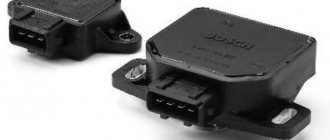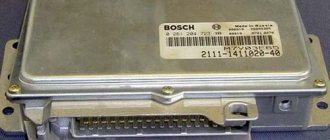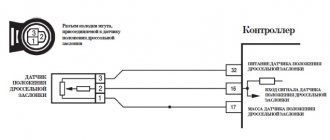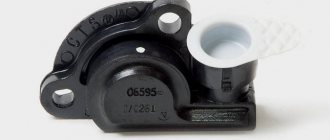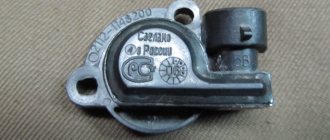Malfunctions of the throttle sensor lead to unstable operation of the car engine. That the TPS is not working correctly can be understood by the following signs: unstable idle, decreased car dynamics, increased fuel consumption and other similar troubles. The main sign that the throttle position sensor is faulty is jumping speed. And the main reason for this is wear on the contact tracks of the throttle valve sensor. However, there are a number of others.
Checking the throttle position sensor is quite simple, and even a novice car enthusiast can do it. To do this, you only need an electronic multimeter capable of measuring DC voltage. If a sensor fails, repairing it is most often impossible, and the device is simply replaced with a new one.
Why is TPS needed?
Most often the sensor is a potentiometer that produces a variable resistance depending on the throttle position (and therefore the throttle position sensor).
The TPS signal is used by the engine control unit (ECM) as one of the input signals of the control system. Ignition timing and fuel injection timing (and possibly other parameters) vary depending on the throttle position, and also depending on the rate of change of this position.
Some throttle valve modifications have built-in limit switches. They are full open and fully closed throttle sensors.
How to fix a problem by cleaning the throttle body
Let's look at how to properly clean the damper step by step:
- First of all, you need to get to the throttle valve. The design of different modifications of the internal combustion engine is different, but, as a rule, it is first necessary to dismantle the air duct running from the damper to the air filter.
- Then you need to remove the throttle valve. You should unscrew the fastening bolts (from 2 to 4 pieces), and then disconnect all the connectors, including the one that goes to the absorber purge valve.
- You can clean the throttle body using carburetor cleaner. Specialized auto chemical stores offer a wide selection of different formulations, so you can always choose the best option in terms of cost.
- Thoroughly wipe the throttle body inside and out using your chosen product and a rag.
- If the car is designed with a protective grille, it also needs to be cleaned.
- Reassemble the assembly in reverse order.
Cleaning the throttle valve is carried out in such a way that its metal surface becomes completely light. Such cleaning will help improve the dynamic characteristics of the engine.
- How to clean the throttle body without removing it
Many car enthusiasts are interested in how to clean the throttle valve without removing it. Some service stations actually offer this service, but it should be borne in mind that effective cleaning of this part can only be done after dismantling the damper.
To clean the throttle valve without removing it, use a special intake tract cleaner. In addition, this procedure can be performed using EGR valve cleaning fluid, as well as WD-40 or solvents.
Algorithm for cleaning the throttle valve without removing it:
- Remove the air duct to provide access to the throttle valve.
- Spray the surface of the damper, which is in the closed position, with cleaning agent and wipe with a rag.
- Open the damper and clean the dirt from the side surface.
- It is necessary to ensure that the cleaning agent reaches all channels (rags are also used for cleaning).
Let us note once again that high-quality cleaning of the throttle valve can only be performed after its dismantling. When installing the part after cleaning, we recommend using a new damper gasket (its cost is quite affordable).
Manufacturers of cleaning products note that the procedure for servicing throttle valves without removal should be carried out every 7,000 - 10,000 km. Cleaning the damper with removal should be carried out at intervals of 30,000 - 50,000 km.
It is important to note that in most situations, after cleaning the damper, it is necessary to adapt it. For this, a special computer is used that connects to the machine's ECU. In addition, “learning” of the throttle valve can be carried out by performing certain manipulations with the ignition and accelerator pedal. In the latter case, it is impossible to give universal instructions, since the procedure will differ for cars of different brands. You need to keep this in mind when adapting the throttle valve.
What types of throttle position sensors are there?
The throttle position sensor is mounted on the throttle body. By design, throttle position sensors are:
- Contact type - with potentiometer.
- Non-contact type - magnetic with Hall effect and inductive (coil).
By installation method:
- Separately installed sensor.
- Built into the damper drive housing.
Damper cost, service life and measures to maintain it in good condition
Prices for throttle valves vary depending on the car model and the manufacturer of the spare part. On average, their cost ranges from 3,000 to 10,000 rubles. The resource of this part is designed for the entire service life of the vehicle. The need to replace the throttle valve may arise due to breakdowns of the motor and its systems, as well as due to a faulty sensor.
Most often, improper operation of the throttle valve is caused by carbon deposits on its elements. Contamination of the remote control leads to accelerated wear of its axis and loose fit of the part in the channel. As a result, control of the volume of air entering the engine is lost. To maintain the throttle valve in working condition, it is necessary to observe the frequency of cleaning it, as well as monitor the condition of the engine and its systems.
The service for replacing the emergency protection at a service station will cost from 900 to 1,500 rubles. In addition, for adaptation of the node you will need to pay from 500 to 700 rubles. Some car repair shops may offer restoration of your car's worn-out electronics or exchange for a refurbished spare part. The price of a restored part ranges from 5,000 to 6,000 rubles.
The principle of operation of TPS with a potentiometer
The TPS sends information to the controller about idle speed, deceleration, acceleration rate and wide open throttle (WOT) status.
The TPS is a three-wire potentiometer. The first wire supplies a voltage of + 5 V to the resistive layer of the sensor, the second wire is ground. The third wire is connected to the potentiometer slider, which changes the resistance and therefore the voltage of the signal returned to the ECU.
Based on the received voltage, the control unit can calculate idle speed (below 0.7 V), full load (about 4.5 V) and throttle opening speed.
At full load, the ECU ensures that the fuel mixture is enriched. In deceleration mode (closed throttle and engine speed above certain rpm), the controller disables fuel injection. Fuel delivery is resumed when the engine speed reaches its idle speed or when the throttle valve opens. On some vehicles these values can be adjusted.
How does TPS differ from its mechanical counterparts?
The main difference between the TPS controller (TPS) is the absence of a mechanical connection between the damper itself and the gas pedal. Engine idle speed is not regulated by moving the throttle body. As a result of the lack of communication, the electronic system can independently change the torque value of the power unit, even if the gas pedal is not pressed. These changes occur due to the operation of input controllers, actuators and the microprocessor unit.
The electronic system also contains:
- gas pedal position regulator;
- brake position switch;
- clutch switch.
Thus, the microprocessor module responds to impulses from the controllers and converts the received signals into control actions on the throttle assembly.
Non-contact TPS
Non-contact throttle position sensors can be of two types - with a Hall sensor and inductive.
Hall effect sensor
TPS with a Hall sensor allows you to receive a signal about the throttle position without physical contact. This makes such sensors more reliable and wear-resistant.
The Hall effect TPS consists of Hall sensors and permanent magnets that rotate around them. There is an air gap between the magnet and the Hall sensor.
The magnet is attached to the throttle shaft, whose angular movement is monitored by Hall sensors. When the damper turns, the magnets change their position.
Hall sensors detect changes in magnetic flux caused by the movement of magnets. The signal is transmitted to the circuit board, which is located in the electronic throttle body, and then to the engine control unit.
The signal sent to the ECU can be analog or digital.
Inductive sensor
Another way to measure rotational position non-contact is with a non-contact inductive type throttle position sensor. Such a TPS consists of a stator and a rotor.
The conductive rotor is a rotating part and is mounted on the throttle shaft. The rotor consists of one or more closed loops with a specific geometry, made of electrically conductive material. May be a round printed circuit board.
The sensor and board with signal processing chip are installed inside the electronic throttle body and are stationary. The stator consists of a standard printed circuit board and an application-specific integrated circuit.
The board contains the receiving excitation coils, as well as electronics for converting the input signal. When the rotor turns, a voltage is induced in the stator, which is transmitted to the ECU to determine the throttle position.
Comparison table of different types of TPS
| Resistive | Inductive | Magnetic | |
| Reliability | Contact principle, prone to wear | Contactless, good | Contactless, good |
| Price | Low | Average | High |
| Size | Big | Big | Average |
| Interface | Analogue only | Analog and digital | Analog and digital |
| Linearity | Very good | Very good | good |
| Reservation | Additional tracks but parallel wear | Additional tracks, sensors | Easy to install two redundant sensors |
Replacing the throttle position sensor and adjusting the new device
In most cases, replacing the sensor is quite simple and you can do it yourself. The whole procedure consists of three main parts: dismantling the old faulty device, installing a new TPS, resetting the error from the ECU memory. In some cases, you will need to adjust the new device.
Actions must be carried out with the ignition off and the sensor de-energized. Unscrew the two fastening screws and remove the connector from the device. Hurray, the old sensor has been removed.
To install a new sensor, you must carefully connect the end of the throttle axis to the device seat. The holes must be aligned while turning the device in a circle. Next, you need to screw in the mounting screws and secure the connector.
To correctly reset the error from the ECU controller, you must leave the terminals disconnected from the battery for at least 8 hours. Within approximately this period, the controller's memory should be reset to zero. The most reliable option, if the first method does not help, is to contact a service center, where the problem will be corrected using a motor tester. On the other hand, you can risk continuing to use the vehicle in a “gentle mode”, hoping that sooner or later the ECU will reset the error on its own.
Signs of a malfunction of the TPS
Acceleration problems
The vehicle lacks power when accelerating or accelerates spontaneously. It may seem like the car just isn't accelerating as well as it should.
The car jerks when it picks up speed. Acceleration may be smooth, but it lacks power.
It may happen that the car suddenly accelerates on its own, even if you have not pressed the gas pedal. If these symptoms occur, there is a good chance that you have a TSD problem.
Floating idle
If you experience engine misfire, floating idle, or stalling, this could also be a sign of a faulty TPS.
This means that the control unit cannot detect a completely closed throttle, i.e. the idle mode is disabled. The TPS may also send incorrect data, causing the engine to stop at any time.
Reduced maximum speed
The car accelerates, but does not exceed a relatively low speed. This is another throttle position sensor failure mode that indicates that it is falsely limiting the power requested by the accelerator pedal.
You may find that your car will accelerate, but not more than 30-50 km per hour. This symptom is often accompanied by a decrease in power.
Check Engine
Check to see if the Check Engine Light comes on, accompanied by any of the following symptoms.
The check engine light may come on if you are having problems with the TPS. However, this is not always the case, so don't wait for the CE light to come on if you notice any of the above symptoms.
Check the vehicle for trouble codes to determine the cause of the problem. This can be done using a diagnostic scanner or an ELM327 adapter with Torque software.
Causes of malfunction of contact sensors
The main reason for failure is wear of the resistive tracks, leading to a complete or partial break in the electrical circuit. This leads to the transmission of incorrect data to the ECU.
Causes of malfunction of contact sensors:
- Wear of the resistor layer leads to loss of electrical contact. This can happen either at the beginning of the slider’s movement (typically when the voltage at the sensor output is low), or on another section of the tracks.
- Broken or worn tip.
- Wear of drive gears.
- Short circuit of signal or electrical circuits.
- Broken wiring, especially for VAZ cars, whose wires are not reliable.
- Oxidation of contacts and contamination of connectors.
Most causes can be diagnosed visually after disassembling the device and using a multimeter.
Regarding error P2135, which was mentioned in the previous section, its causes:
- poor ECU contact ground;
- oxidation of contacts in the connector;
- main relay malfunction;
- short circuit and other reasons.
How to check TPS
Here we will talk about how to test throttle sensors, what malfunctions may occur and how to identify them.
Voltage check
- Connect the black lead (negative) of the digital multimeter to the case or negative of the battery.
- Locate the reference voltage (+5 volts), ground, and signal voltage terminals.
Most throttle potentiometers have three terminals, but some may have additional terminals that function as throttle ends.
- Connect the multimeter's red lead (positive) to the signal voltage terminal.
- Turn on the ignition, but do not start the engine. In most vehicles the voltage reading should be less than 0.7V.
- Open and close the throttle valve several times, checking that the voltage changes smoothly.
Checking the sensor resistance
- Disconnect the sensor connector.
- Connect a multimeter in resistance measurement mode (Ohms) between the potentiometer slider terminal and the reference voltage terminal. Or between the runner and the ground.
- Open and close the throttle valve several times and check for a smooth change in resistance. If the potentiometer resistance is infinite or zero, this indicates a malfunction.
- We do not indicate the exact resistance values of the potentiometer. One reason is that many manufacturers do not publish benchmark data. The fact that the resistance of the potentiometer is within certain limits is less important than the correct operation of the potentiometer, that is, a smooth change in resistance when the throttle valve is moved.
- Connect the multimeter between ground and the reference voltage pin. The resistance must be constant.
- If the resistance is infinite or small, the potentiometer must be replaced.
Checking the performance of the TPS
If during operation of the vehicle at least one of the signs of malfunction of the throttle position sensor was detected, its functionality must be checked. To do this, the car owner does not require any special knowledge. It is enough to have a multimeter and know a clear sequence of actions.
The main thing to remember is that the Check Engine is a light that is installed specifically to signal the driver about a faulty engine. If it lights up, then you need to immediately contact a service station or fix the problem yourself.
If there are no problems, the light will light up when the engine starts and go out instantly when the diagnosis is complete. If the Check Engine light remains on, there is a problem with the system. In this case, you cannot do without an experienced specialist.
Regarding the identification of throttle valve malfunctions, the symptoms of which were identified during the operation of the car, there is a certain algorithm of actions:
- The first thing you need to do is turn off the ignition, inspect the instrument panel, notice whether the Check Engine indicator light is on or not, which signals the presence of problems. If the indicator does not light up, you need to climb under the hood and check the TPS.
- Next, you will need a multimeter - a special device to check the operation of the throttle sensor.
- It is necessary to determine the presence of a “minus”. In order not to discard each wire separately, it is worth piercing the necessary wires and measuring them.
- The search for “mass” is carried out in the same way. There is no need to turn on the ignition during the mechanism check period.
The purpose of performing preliminary actions is to check the availability of power to the PD sensor. The voltage depends on the make of the car. For example, for some machines it may be only 5 V, while for other models it may be 12 V.
Algorithm of actions for identifying TPS faults, the symptoms of which were identified while the vehicle was moving:
- you need to turn on the ignition and pierce the wires of the required chain one by one using a multimeter. The device display should show a voltage reading of 0.7 V;
- the throttle valve opens manually: the voltage value must be greater than 4 V;
- The ignition is turned off, one connector is discarded. In the area between the slider terminal and the wire (which remains), a multimeter probe is connected;
- Now you need to manually scroll the sector and observe the readings of the measuring device. If there is a smooth increase in values without sudden jumps, it means that the PD sensor is working normally. In the opposite situation, we can talk about damage (scuffing) of the resistor track.
These indicators affect the proper functioning of the electronic control unit (ECU), which controls the main operating processes of a car engine and the supply of fuel mixture to the injectors. If inaccurate numbers are supplied to the ECU, then the control unit will make incorrect decisions.
For example, the throttle valve is fully open, but the electronic device shows that it is closed. If such symptoms are present, this is an obvious malfunction of the throttle sensor and must be replaced.
Troubleshooting throttle position sensor
Chaotic output signal
The signal voltage changes sharply and may drop to zero. When the throttle sensor output is erratic, it is usually caused by a faulty potentiometer. In this case, the sensor must be replaced.
No voltage signal
- Check the presence of reference voltage (+5.0 V) on the connector.
- Check the condition of the potentiometer ground contact.
- Check the signal wire connecting the sensor to the control unit.
- If problems are found with the reference voltage and grounding, check the continuity of the wires between the TPS and the ECU.
- If the sensor wires are OK, check all power and ground connections to the controller. If everything is fine with them, the most likely cause is the control unit itself.
How to clean and check injectors yourself
To clean the injector with your own hands, you need to prepare the following elements: a special means for cleaning injectors and a tube with an internal diameter of no more than 5 millimeters, as well as two identical wires, a car battery and any button equipped with large contacts, or better yet, a relay.
The injector is removed from the rack and connected to the battery. Before you close all the wires, you need to break the positive wire and install a button with a built-in relay in this place. After this, a small tube of cleaning agent is inserted into the nozzle, reinforced with a thick tube measuring up to 5 millimeters. After this, the button applies voltage, the nozzle opens, and the cleaning agent is released into the nozzle.
It turns out that during this process a complete simulation of the operation of the fuel injector occurs. Firstly, it is driven, and secondly, in this way its suitability for further use can be determined. A suitable injector is considered to be one from which fuel is sprayed and not poured. A leaking injector must be replaced or repaired.
The liquid must be run within 3 minutes. During this time, the part will be completely cleaned and will be suitable for further use. After cleaning, the nozzle is installed on the rail and inserted into the intake system. Before installation, do not forget to check the reliability of the seals. If they are visually in poor condition, then they need to be replaced. Try not to bypass the problem of rubber bands, as this will result in a fuel leak for you, and, as a result, an accelerated and useless increase in fuel consumption.
Never put off purchasing new seals until tomorrow. This must be done in advance and in accordance with the make and model of your car. Externally, a repair kit for two slightly similar injectors may differ noticeably.
Do-it-yourself TPS restoration
Graphite glue
I decided to remove and disassemble the sensor to check the integrity of the graphite tracks by eye. Having taken it apart, I saw that the graphite tracks were indeed erased; I cannot determine the degree of wear. It was decided to purchase graphite glue to restore the board tracks. I found the most suitable one in the Chip and Dip store, costing 150 rubles.
Restoring sensor tracks with graphite glue.
I removed the damper sensor and carefully cut it with a hacksaw because... There is no other way to open it, I carefully bent the board and applied a thin layer of glue to the tracks. I assembled and glued everything together, all that remained was to adjust the throttle position sensor, which I actually couldn’t do myself, even with a diagnostic adapter, a multimeter and probes on hand.
The next day I went to the service station to adjust the throttle position sensor. The slipping of the car was terrible; when changing gears in different positions, the revolutions jumped from 2500 to 4000 thousand.
The photo shows very worn tracks
At 100, the technician reset everything to the car’s factory settings and adjusted the throttle position. At idle everything was fine, but on the way home I noticed slipping from 2nd to 3rd gear. It wasn’t strong, for example, if switching occurs at 1800 it increases to 2000, if at 1700 it increases to 1900 thousand, but if you apply gas this does not happen.
I started reading because I had thoughts in my head about burnt (worn out) clutches because... On the day of visiting the service station, I had to drive for a couple of hours with terrible slippage, but soon I immediately discarded this reason.
I called the service station and again spoke in detail about the problem, the master suggested that I check the wiring and automatic transmission, and not blame the damper sensor, since I was only thinking about it, I went to disassemble it again.
The method that helped
This time, I did not remove the throttle position sensor itself, so as not to have to go adjust it again, but removed the damper completely from the car, bent the board with the tracks and carefully cleaned it of the graphite glue that I had applied before.
Inside the TPS there are graphite tracks along which the brushes move. The most effective way to repair
- this is to bend these brushes to the sides along a whole part of the paths, this must be done very carefully, I used thin tweezers and flat tweezers.
Don’t think of degreasing the tracks or lubricating them with anything special using cotton swabs and sponges. These brushes need to be carefully bent.
This time, I planned to solve the problem
bending the brushes onto entire parts of the TPD tracks. I assembled it, started it and went to check it out. The ride is smooth, there is no slipping, the speed remains at 1400, 1650 at 1900 thousand, etc. in general, everything is as it should be, you can make the repair yourself and revive the damper sensor before buying a new one, the main thing is to do everything carefully and slowly.
Replacing TPS
- Removing the sensor from the car is necessary to install a new one. First of all, you need to turn off the electrical power by disconnecting the battery terminals. The wires that are connected to the device also need to be disconnected. After unscrewing the mounting bolts, the TPS can be removed. When installing a new, original spare part, no adjustment is required.
- Direct installation of a new device. To begin with, the spare part is connected to the electronic control unit, after which the terminal is put on the battery. With this algorithm of actions, all factory settings will be saved. Attention: it is important to install only original devices. A sensor from another car model is not suitable. The necessary device can be purchased in special stores or from an official representative of the car brand. Buying online or on the market most often leads to the acquisition of counterfeit goods. The choice of seller should be taken carefully and seriously.
avtoexperts.ru
The operation of any injection engine is controlled by electronics in the form of an ECU (electronic control unit), the operation of which is based on the readings of a group of sensors that monitor the state of various engine systems and components.
One of this group of sensors is the TPS. It is installed directly on the damper axis and monitors the slightest change in its position.
In turn, the throttle valve serves to change the air supply to the engine to form the optimal composition of the air-fuel mixture, and the controller needs exactly this information about the amount of incoming air.
TPS and IAC
Based on data on the amount of air supplied at a given time, the ECU calculates the fuel rate to create the optimal mixture for its complete combustion in the engine cylinders. This in turn will guarantee full power output from the power unit and its economical operation.
How does the sensor work?
The throttle position sensor is a regular potentiometer (a variable resistor, it works like, for example, a volume control in radio equipment) with a sliding contact, thanks to which the voltage at the output of the device changes from zero to maximum.
Any potentiometer is equipped with three terminals, two connected to the ends of the winding, and one to the moving contact. One of the terminals is used to supply voltage, the second is “ground” and the third is used to communicate with the control unit.
new sensor
Typically the winding is made in the form of a flat spiral with equal distances between the turns, or it can be a plastic film coated with a resistive layer in the form of one or two tracks.
Principle of operation
When the throttle valve is closed, there is no signal from the sensor to the control unit and the voltage has background values. As the damper opens to a certain angle, the voltage increases, up to a maximum when it is fully opened.
Scheme of work
Each damper position corresponds to a certain voltage value, by which the controller determines the amount of incoming air in order to command the injectors to supply a certain dose of fuel. If the ECU receives a signal from the sensor that the damper is completely closed, it issues a command to open the IAC to supply air through the bypass channel.
What types of malfunctions occur?
In most cases, sensor failure is caused by wear of the spiral turns, track spraying or the working part of the runner. The part of the track where the slider moves most often is subject to wear, which corresponds to the position of the gas pedal while driving, when the engine is running at a certain speed.
Sensor failure can also be caused by oxidation of the contacts or dirt getting into the connection.
dirty throttle valve
Inadequate sensor readings can also be caused by sticking of the throttle valve due to accumulated dirt and carbon deposits.
Sensor malfunctions are expressed in unstable engine speed, jerks during acceleration, a drop in power and engine stopping after removing your foot from the accelerator pedal.
How to check the operation of the sensor?
You will need a multimeter to check.
• The tester switches to voltmeter mode. The chip is removed from the sensor and with the engine running, the voltage between the power and ground terminals is measured. The device should show about 5V (+/-);
• The ignition is turned off and the tester is set to check the resistance. Then, with the damper completely closed, the resistance is measured between the sensor terminals: “ground” and the contact for the control unit. The device should show 0.8-1.2 kOhm;
• Next, repeat the measurement with the damper fully open, where the device readings should correspond to 2.3-2.7 kOhm.
If the test reveals that the sensor is faulty, it must be replaced.
Replacing TPS
• Remove the power supply from the sensor;
• Release the fastening bolts;
• Carefully connect the end of the damper shaft to the recess in the sensor;
• Install the fastening screws;
• Reinstall the connector.
After replacement, it is necessary to reset the error from the ECU memory . To do this, remove the battery terminals to reset the memory.
On some brands of cars, after installing the sensor, it must also be adjusted.
Adjustment procedure:
• Close the damper completely;
• Connect the tester probes (on the voltmeter scale) to the engine ground and the sensor output;
• Then, loosening the fastening screws, turn the sensor until the moment when the device shows the lowest voltage (0 V, with an ideal ratio, but “live” it can show a little more);
• Having reached the minimum value of the voltmeter, tighten the mounting bolts.
In case of increased engine speed after adjustment, it is necessary to familiarize the ECU with the characteristics of the new sensor.
For this:
• Remove both terminals from the battery for 15-20 minutes;
• Replace the terminals and make sure that the throttle valve is completely closed;
• Turn on the ignition for 10-15 seconds without starting the engine and turn off;
• Wait 15-20 seconds so that the ECU can “remember” the data of the new sensor.
The average cost of TPS for various car models is about 1,500 rubles.
TPS adjustment
To properly adjust and configure the operation of the controller to avoid errors, do this:
- The engine compartment of the car is opened, the corrugated hose that goes to the intake manifold is removed. Before adjusting the device, you need to visually inspect the condition of the damper. If there is contamination, the element must be cleaned with a rag soaked in gasoline. It would be a good idea to clean the intake manifold.
- Then you need to loosen the throttle stop screw (this component opens all the way and is released). When this action is performed, you can hear the click of the strike against the stop.
- The tension of the thrust screw is adjusted (when performing this task, you must click the damper). If this element stops jamming and moves freely, the bolt must be secured with a nut.
- The next step is to loosen the screws securing the regulator. Take a multimeter, since without it you won’t be able to adjust the controller’s operation. One output of the device must be connected to the contact component of the idle speed sensor, the second must be connected between the damper and the stop screw.
- Then the regulator body begins to rotate. This occurs until the voltage value on the multimeter display changes with the opening of the damper.
- Once the adjustment is complete, the locking screws can be tightened.
User Dmitry Maznitsyn spoke in detail about independently performing TPS adjustment with his own hands using the example of a Volkswagen Passat.
Sensor calibration
If the device has been adjusted, it may require additional calibration before use.
This process includes the following steps:
- The battery terminals are disconnected. Using a wrench, the clamp on the negative terminal is loosened. After turning off the power in the on-board network, you must wait at least twenty minutes.
- The terminal clamp is installed back. At this stage, you need to make sure that the damper is completely closed. If not, then you need to do this.
- The key must be installed in the switch, the ignition is turned on for approximately 15 seconds. The engine does not start. Afterwards the ignition can be turned off.
- Now you should wait about twenty seconds. The control unit must remember information about the technical parameters of the sensor.


